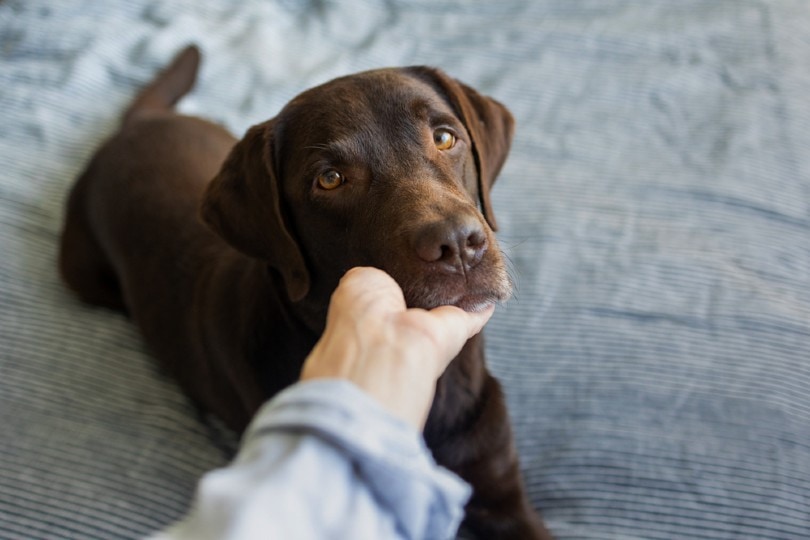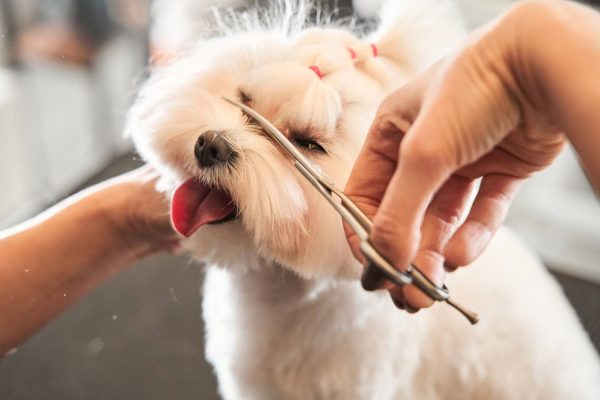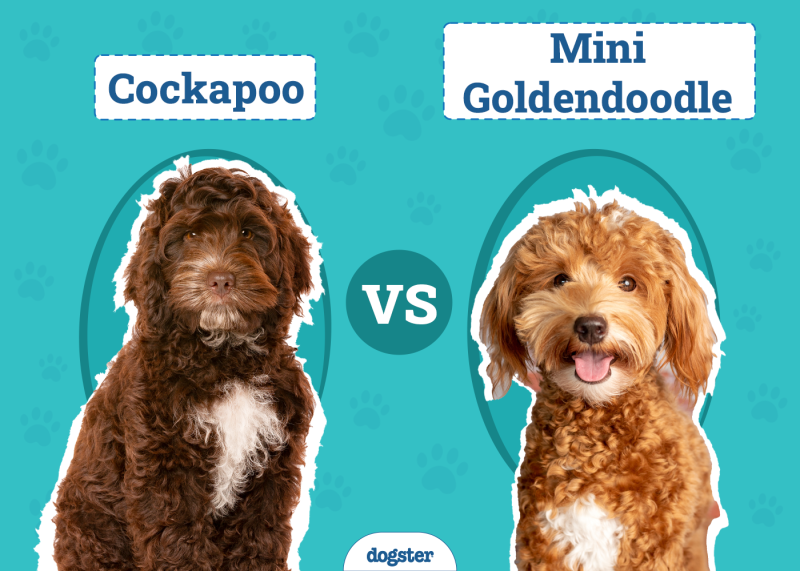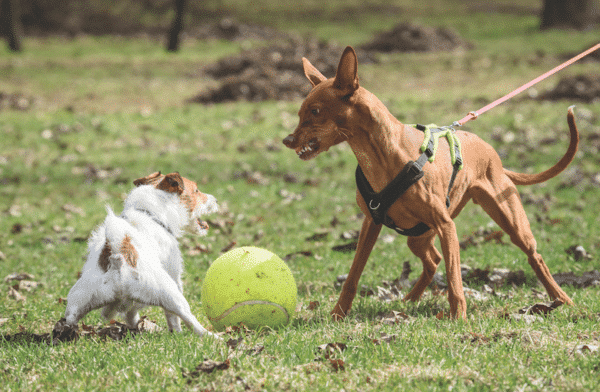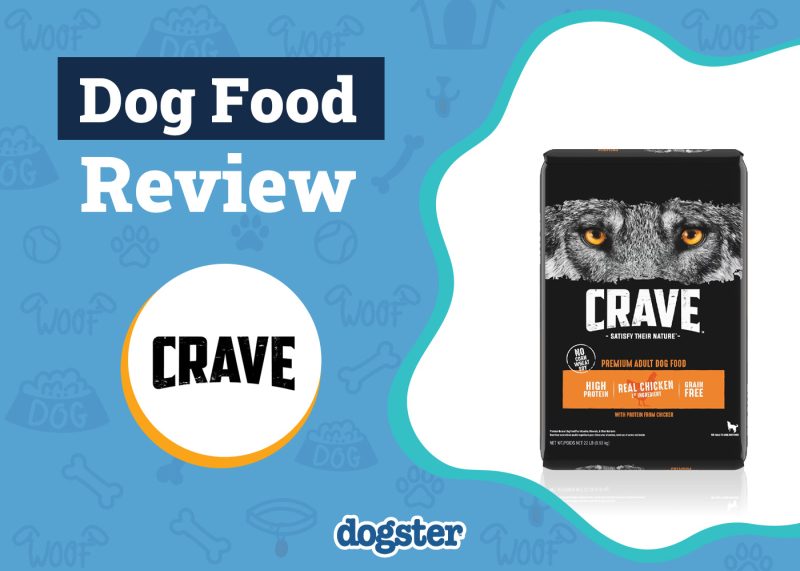Some owners may see chaining or tethering a dog as convenient, but the psychological and physical damage it can do to dogs often has terrible consequences. Chaining or tethering a dog is physically harmful and detrimental to their well-being.
In addition, the chaining or tethering of a dog sharply increases its likelihood of showing aggression or inflicting severe dog bites, as well as putting your dog at risk of strangulation, choking, or crushing injuries to the windpipe and tissues of the throat.
Tethering or chaining a dog is illegal in 23 states, and it’s considered inhumane and against the universal five animal welfare freedoms, as a dog’s needs are simply not met at the end of a tether. This article looks at and explores 16 reasons why you should never chain or tether a dog.

The 16 Reasons You Should Never Chain or Tether a Dog
1. It Causes Psychological Distress
Studies conducted on tethered and untethered dogs show that tethered or chained dogs suffer from psychological damage, including aggression, fear, and anxiety, with the constant stress of being confined.
Being tethered or chained causes extreme isolation. Dogs are incredibly social animals that are domesticated to live alongside humans, not in solitary confinement and at the end of a chain. Depression and anxiety go hand in hand with tethering a dog this way, which is the tip of the iceberg when it comes to damage.
Good psychological well-being means to be free from distress. Tethering a dog does nothing but cause instant distress and learned helplessness—the state in which a dog gives up entirely on life, as they have been put through so much pain and trauma—is the most heartbreaking consequence for those dogs that survive 24/7 confinement.

2. It Triggers Aggression
The CDC conducted a study that concluded that chained dogs are 2.8 times more likely to bite than unchained dogs. The fight or flight response is an animal’s way of dealing with high-stress situations in response to cortisol secretion. Unsurprisingly, when a dog is chained, this stress is magnified.
Because a dog cannot escape the situation (such as a stranger walking into its territory or approaching it), the flight option is taken away, so all that’s left is to fight. Between 2003 and 2007, 175 children were seriously injured or killed by chained dog attacks, and devastatingly, most attacks by dogs that are chained are inflicted on children who don’t understand the dog is agitated.
Chained dogs constantly defend their tiny area of territory and become fiercely protective of the things they own within that space (such as food and water bowls). This aggression remains if the chain or tether breaks, meaning that dogs who break free of their binds are likely to chase and attack other pets and people due to these severe, acquired behavioral issues.
This intensely territorial behavior includes lunging, biting at the air, and growling/barking.
3. It Can Cause Strangulation
Dogs can be killed by strangulation if their tether gets caught up and they cannot get free. It may seem unlikely, but dogs under severe psychological distress can lunge and twist to try and get free of their chains, get themselves caught over a branch or a kennel, and hang themselves.
Strangulation and hanging injuries happen more often than you think, and dogs can get their legs caught up and hurt in the chain. Panic can hasten this process; if a dog gets a length of rope or chain wrapped around them, it will struggle and thrash to free itself. Unfortunately, this will inadvertently hang them, tightening the ligature and choking off their air.

4. It Can Cause Starvation or Dehydration
Dogs restricted by chains often knock their food and water bowls out of reach, meaning they can quickly starve or become dehydrated if their owners ignore them. Food left outside can also attract flies and animals that may either take their food or decide to attack the helpless dog.
5. It Will Make the Dog More Unmanageable
Contrary to the popular belief that chaining a dog will “calm it down,” chaining a dog can cause behavioral issues and aggravate them into a frenzy, meaning the longer they’re chained, the more unmanageable they become.
Dogs that have been tethered for a long time and then released often don’t know how to act socially around people or other animals, leading to extreme behavioral abnormalities.
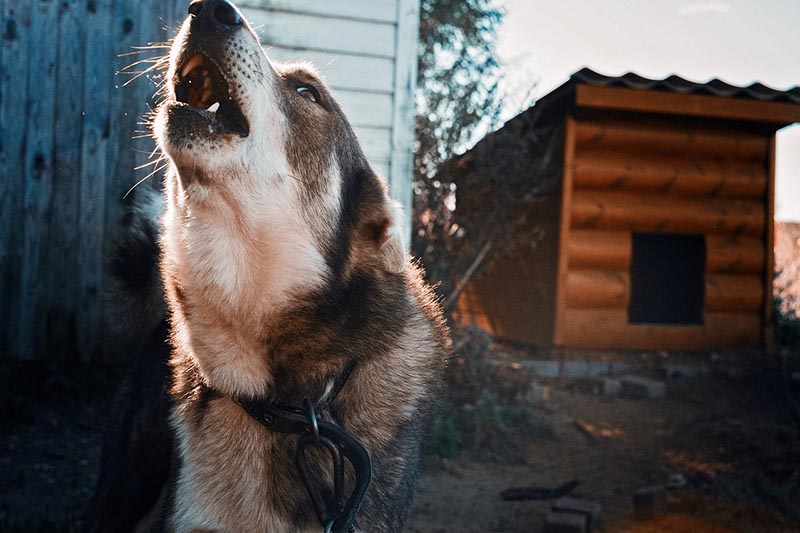
6. It Can Cause Physical Injury
The constant rubbing and constriction of the collar or tether around a dog’s neck can cause friction burns or cuts into the skin. This is especially true for puppies tethered and then left outside; as they grow, the collar will squeeze their neck and eventually cut into their skin.
Pulling and lunging at the chain can also cause horrible wounds and injuries to the windpipe and neck tissues.
7. It Offers No Protection From the Weather
If a dog is tethered outside with no shelter or shade (and no way to get to those things), they are at the mercy of the weather. Heat stroke, heat exhaustion, sunburns, and hypothermia are all genuine dangers for dogs kept outside all the time, and these conditions can quickly become fatal.

8. It Makes the Dog Vulnerable to Other Dogs or Predators
A dog that is chained to one spot cannot run away from predators and has a huge disadvantage when trying to defend itself from them. The dog is forced to stay out and fight, which can mean death if a large predator like a fox, bear, or mountain lion decides to attack them.
9. It Leaves Them at the Mercy of Insects
Fleas and ticks can easily latch onto dogs kept outside, and if a dog is young or weak, a heavy infestation can cause anemia and even kill them. Other biting insects, such as mosquitos, are also a threat to a dog tethered outside, as well as biting flies.
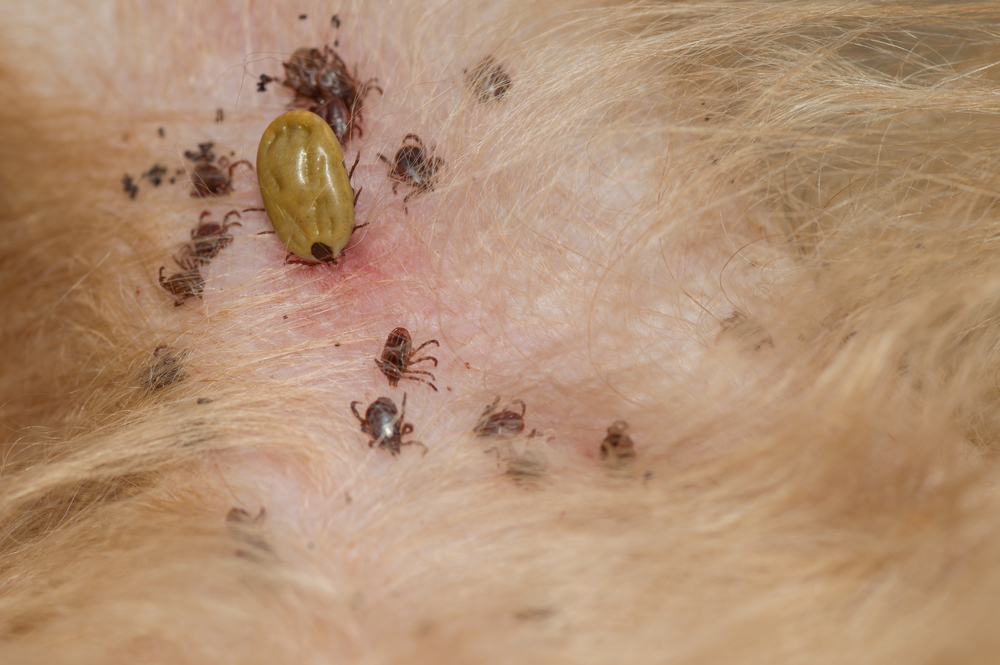
10. It Can Cause Urine and Feces Scalding
A tethered dog can only defecate and urinate in a small circular area, which is also where they’re forced to eat and sleep. These unhygienic conditions heighten urine burns and the possibility of infection, and a dog can quickly get sick if forced to eat where they use the bathroom.
11. If They Break Free, They’ll Never Return
A dog that is chained generally will not return to the owner who chained it. Even if the dog is only chained for a short time, the experience is so traumatic that if they manage to break free, they will run as fast as they can, and this usually never ends well for the dog, as they are often ill-prepared for life outside of a rope.
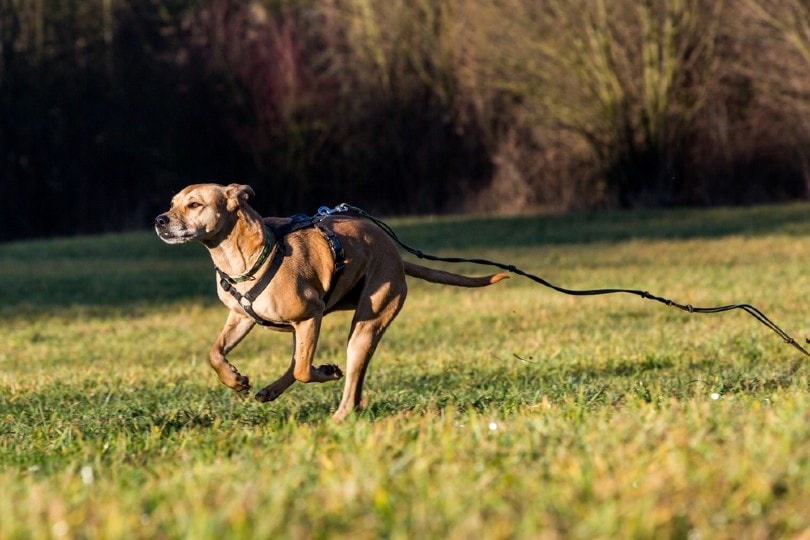
12. It Can Cause Excessive Barking
Frustration and boredom create the perfect mix for excessive barking. Not only will neighbors not appreciate a dog barking day in and day out, but the dog showing distress is one of the only ways it can.
13. It Doesn’t Allow for Any Exercise
It can be very hard for tethered dogs to get adequate exercise, particularly if tethered on a short chain. This means they can suffer from cardiovascular, muscular, and neurological diseases and problems if they’re kept confined for too long.
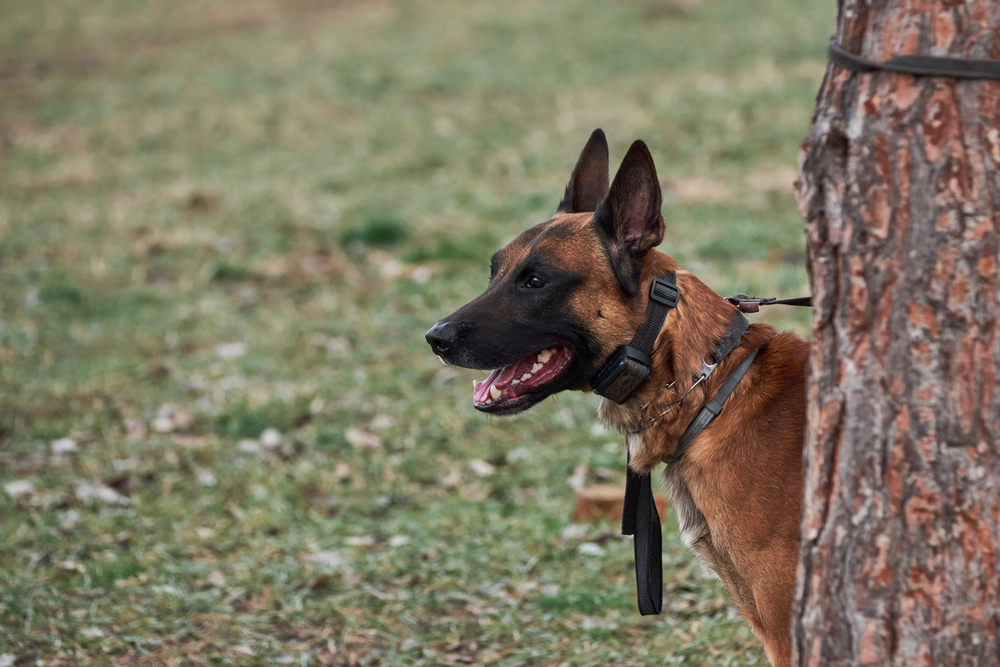
14. Tethering or Chaining is Illegal in Some States
In 23 states in the USA, tethering for certain periods is prohibited, and the welfare issues it poses are well known. States such as Delaware, California, and Connecticut restrict tethering, and in some states, such as Massachusetts, a dog can be tethered for no longer than five hours.
Restrictions to the weight of the chain and being chained in outside weather are also implemented by certain states.
15. It Is Unethical and Cruel
Animal welfare groups, charities, and shelters all agree that chaining or tethering a dog for an extended period is unethical, unnecessary, cruel, and extremely detrimental to a dog’s welfare.
Dogs should be inside with their owners in the family home and should be afforded the same love and care we would give any other family member. Leaving a dog on a tether also breaches the five welfare freedoms, which state:
- The freedom from hunger and thirst
- The freedom from discomfort
- The freedom from pain
- The freedom to exhibit natural behavior
- The freedom from fear and distress
16. It’s Dangerous
Above all, tethering a dog is dangerous for both the dog and the people around them. The extreme behavioral changes chaining can cause, along with the pain and suffering it inflicts on dogs (including the risk of strangulation and death), means that no dog should ever be tethered longer than a few minutes, which some states write into law.

Can I Chain or Tether a Dog at All?
There are some times when a tether is useful and even necessary, such as outside a store that doesn’t allow dogs, for example. However, you should not leave your dog there for long (ideally a maximum of an hour or two) and the dog should always have water, and shelter, and be safe to be in public.
Being able to tether your dog is a safety measure, and it can even be considered a tool on some occasions. You definitely will not need a chain, as the leash should be enough to ensure your dog doesn’t get scared or curious and go elsewhere while you quickly run some errands. We recognize that this is a resource or tool, but it should only be used within humane limits, when absolutely necessary. The place of a dog is with their pack, which in the case of pet or company dogs is their humans. A dog is not meant to be kept attached to a chain, in fact, no living being should live this way.
Our recommendation would be first to train your dog to wait while leashed, gradually increasing the time increments using positive reinforcement. Once your dog is trained and comfortable with the tether, you can safely leave them for brief periods when needed. Your dog will learn that you will return shortly and everything is ok, without getting anxious or being restrained excessively.
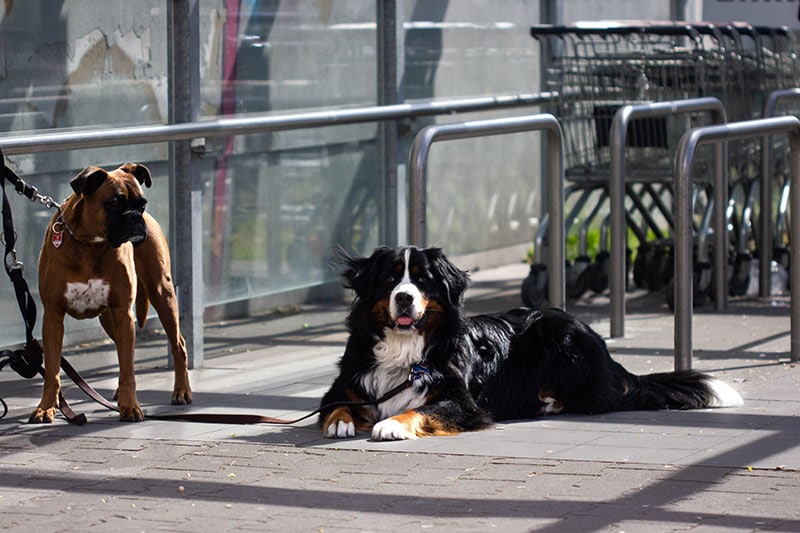

Conclusion
Chaining and tethering dogs are cruel and are recognized as inhumane in many parts of the world, despite longstanding “traditions” upheld by some owners. Tethering a dog doesn’t make them a better guard dog, nor does it “keep them in check” or “calm them down”.
All it does is cause terrible distress, devastating behavioral issues (which can lead to avoidable injury and fatality to people), and a dog that no longer knows how to be happy.
Keeping your pup attached while they patiently wait for you is a resource that can be useful in brief, urgent situations, but it should be used only as a resource when absolutely necessary and not as the dog’s general living conditions.
Featured Image Credit: My July, Shutterstock

